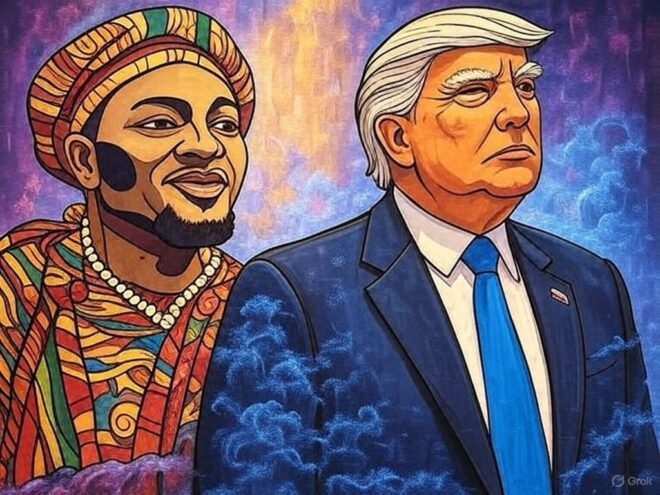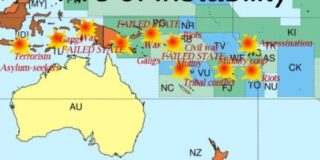
When I last visited the Musée du Quai Branly in Paris, a haven of global cultural artefacts, I was captivated by the vibrant masks, intricate sculptures and the stories they told of distant traditions. In the museum’s shop, I purchased a book on Eshu, the trickster god of the Yoruba people of West Africa, a deity whose complexity and duality fascinated me. Eshu, known for creating misunderstandings and thriving at the crossroads of human experience, is a sacred provocateur, a figure who uses chaos to reveal truths and prompt transformation. As I reflected on this mythology, I couldn’t help but draw parallels to Donald Trump and his MAGA movement, whose polarising presence in modern politics mirrors Eshu’s disruptive energy. Extending this lens, historical figures like Socrates, Cleopatra, Robin Hood and Voltaire also embody trickster-like qualities, challenging norms and reshaping their worlds through ambiguity and discord. This essay explores the trickster archetype through Eshu’s mythology, examines Trump as a modern manifestation and traces its echoes in these historical figures, illustrating how tricksters – divine, historical, or contemporary – disrupt to expose societal truths.
Eshu: The Yoruba Trickster God
In Yoruba mythology, Eshu (also Esu or Elegba) is one of the Orishas, divine beings mediating between humanity and Olodumare, the supreme creator. As the god of crossroads, communication and chance, Eshu governs transitions and transformations, embodying both creative and destructive forces. He is the keeper of ase, the life force animating existence and his role is to maintain balance by testing human character. Unlike Western tricksters often reduced to mischievous pranksters, Eshu is a profound figure, sacred yet unpredictable, whose chaos serves a cosmic purpose.
Eshu’s trickster nature shines in stories of deliberate provocation. In a famous tale, he walks between two friends wearing a hat red on one side and white on the other. Each friend, seeing only one side, argues fiercely about the hat’s colour, nearly coming to blows. Eshu later reveals the truth, showing both were partially correct but limited by perspective. This story captures his role in creating misunderstandings to expose flaws – pride, stubbornness, or narrow-mindedness. His chaos prompts reflection, forcing individuals to confront their limitations. As a messenger, Eshu carries prayers to the divine, but may distort them if humans neglect him, reinforcing his dual role as ally and adversary.
Eshu’s domain at the crossroads symbolises his mastery of liminality, where choices shape destinies. Neither wholly good nor evil, he challenges binary thinking, often exposing hypocrisy or catalysing change. In Yoruba cosmology, Eshu is indispensable, reminding us that order and chaos are intertwined and disruption is necessary for progress. His shape-shifting, ambiguous nature makes him a universal archetype, resonating across cultures and eras in figures who disrupt to reveal.
Donald Trump: A Modern Trickster
At first glance, likening Donald Trump, a polarising American political figure, to a Yoruba deity seems improbable. Yet, the trickster archetype transcends cultural boundaries, manifesting in those who disrupt norms and thrive in chaos. Trump, with his unorthodox style and ability to polarise, mirrors Eshu’s traits, particularly in fostering division, navigating ambiguity and challenging established systems.
1. Creating Misunderstandings and Division
Like Eshu, Trump sows discord through ambiguous, inflammatory rhetoric that invites conflicting interpretations. His 2016 promise to “build a wall” or 2020 claims of a “stolen election” function like Eshu’s hat: to supporters, they are bold truths; to critics, dangerous falsehoods. These statements deepen societal rifts, revealing fault lines in identity, truth and power. Trump’s dominance of discourse ensures these misunderstandings persist, much like Eshu’s provocations expose human divisions. His rallies and social media amplify this effect, creating a feedback loop of polarisation that mirrors Eshu’s role in stirring conflict to prompt reflection.
2. Thriving at the Crossroads
Eshu’s crossroads symbolise liminal spaces where destinies shift and Trump operates at a similar intersection of politics, media and culture. His journey from reality TV star to president defies traditional political paths, positioning him as a figure who thrives in ambiguity. His use of Twitter (now X) echoes Eshu’s role as a messenger, bypassing gatekeepers to reach millions directly. Yet, his messages – often cryptic or contradictory – leave room for interpretation, amplifying their impact. Trump’s ability to pivot from one controversy to another keeps him central, much like Eshu’s presence at the crossroads of human affairs.
3. Challenging Norms and Exposing Hypocrisy
Tricksters disrupt systems to reveal flaws and Trump’s outsider status challenged the entrenched elites of both parties. His rejection of political correctness exposed their disconnect from segments of the electorate, resonating with those feeling ignored. His critiques of “fake news” highlighted media biases, though his own claims were often unverifiable, mirroring Eshu’s dual role as truth-teller and deceiver. These disruptions forced society to grapple with contradictions – economic inequality, cultural divides – much as Eshu’s chaos reveals uncomfortable realities.
4. Ambiguity and Duality
Eshu’s refusal to be categorised as good or evil finds a parallel in Trump’s enigmatic persona. To MAGA supporters, he is a saviour, championing “America First”; to detractors, a demagogue threatening democracy. This duality fuels his trickster-like power, allowing him to evade conventional labels. His unpredictable shifts – from conciliatory to combative – keep allies and opponents off balance, akin to Eshu’s shape-shifting. This ambiguity ensures Trump remains a focal point, shaping narratives even out of office.
The MAGA movement amplifies Trump’s trickster influence, resembling Eshu’s followers who offer sacrifices for favour. Its slogans – “Make America Great Again,” “Drain the Swamp” – are evocative yet vague, inviting diverse interpretations like Eshu’s provocative acts. The movement’s fervour, from the January 6 Capitol riot to ongoing cultural battles, echoes Eshu’s chaos, though its purpose – whether transformative or divisive – remains contested. Unlike Eshu’s sacred framework, Trump’s motivations seem personal, driven by ego or ambition, raising questions about whether his chaos can yield Eshu’s redemptive clarity.
Historical Tricksters: Echoes of Eshu
The trickster archetype, embodied by Eshu and reflected in Trump, extends to historical figures who disrupted their eras through chaos and ambiguity. Socrates, Cleopatra, Robin Hood and Voltaire each mirror Eshu’s role in creating misunderstandings, challenging authority and thriving at societal crossroads, reshaping their worlds in ways that resonate with Trump’s modern disruptions.
1. Socrates: The Philosophical Gadfly
Socrates (470–399 BCE), the Greek philosopher, embodies the trickster through his relentless questioning of Athenian complacency. His Socratic method, a series of probing questions, dismantled assumptions, leaving interlocutors confused or contradicted, much like Eshu’s hat trick. In Plato’s Euthyphro, Socrates challenges a priest’s definition of piety, exposing intellectual limits. Operating at the crossroads of tradition and emerging philosophy, he criticised both democrats and oligarchs, embodying Eshu’s duality – neither fully ally nor enemy. His role as Athens’ “gadfly” stirred intellectual chaos to push for truth, but his trial and execution for “corrupting the youth” reflect the backlash tricksters face. Socrates’ legacy, like Eshu’s, lies in forcing society to confront unexamined beliefs, reshaping Western thought.
2. Cleopatra: The Cunning Diplomat
Cleopatra VII (69–30 BCE), Egypt’s last Ptolemaic ruler, wielded intelligence and charisma as a trickster in a male-dominated world. Like Eshu, she thrived at the crossroads of Egyptian and Roman cultures, using linguistic prowess and theatrical displays to maintain autonomy. Her relationships with Julius Caesar and Mark Antony were strategic, creating misunderstandings about her intentions that kept Rome off balance. Her Tarsus arrival – sailing as Aphrodite on a golden barge – was a spectacle akin to Eshu’s provocations, disarming Antony. Her dual persona – divine pharaoh to Egyptians, seductress or diplomat to Romans – mirrors Eshu’s shape-shifting. Though defeated by Octavian, Cleopatra’s disruptions prolonged Egypt’s independence, her legacy reflecting the trickster’s power to challenge power structures.
3. Robin Hood: The Outlaw Disruptor
Robin Hood, a semi-legendary figure from medieval England (12th–13th centuries), embodies the trickster as a social rebel. Stealing from the rich to give to the poor, he upended feudal order, exposing the greed of figures like the Sheriff of Nottingham, much as Eshu reveals inequities. His disguises – beggar or noble – echo Eshu’s shape-shifting, allowing him to navigate social boundaries. Sherwood Forest, his base, was a liminal space where norms dissolved, akin to Eshu’s crossroads. His duality – hero to the poor, villain to the powerful – parallels Eshu’s ambiguity. Though his historicity is debated, Robin Hood’s myth, amplified in ballads, reflects the trickster’s ability to inspire change by exposing systemic flaws.
4. Voltaire: The Satirical Firebrand
Voltaire (1694–1778), the French Enlightenment writer, used satire as a trickster-like weapon against religious dogma and oppression. His works, like Candide (1759), exposed absurdities in optimism and clerical hypocrisy, creating intellectual chaos akin to Eshu’s misunderstandings. Navigating the crossroads of elite and popular discourse, he used pseudonyms and exile to evade censorship, mirroring Eshu’s elusiveness. His duality – champion of reason, reviled agitator – echoes Eshu’s refusal to be categorised. His defence of tolerance in the Calas Affair (1762) stirred outrage against injustice, reshaping attitudes toward fairness. Voltaire’s disruptions, like Eshu’s, laid the groundwork for transformative change, influencing the French Revolution.
Comparative Analysis: Trickster Traits Across Time
Eshu, Trump and these historical figures share core trickster traits, tailored to their contexts:
• Creating Misunderstandings: Eshu’s hat trick finds parallels in Socrates’ dialogues, Cleopatra’s political theatre, Robin Hood’s subversive acts, Voltaire’s satire and Trump’s rhetoric. Each generates confusion to expose truths – intellectual limits, cultural tensions, feudal inequities, institutional hypocrisy, or societal fractures.
• Thriving at the Crossroads: Eshu’s liminal domain is mirrored in Socrates’ philosophical bridge, Cleopatra’s cultural navigation, Robin Hood’s forest, Voltaire’s discourse and Trump’s media-political nexus. Each leverages ambiguity to influence outcomes.
• Challenging Authority: All defy entrenched powers – Eshu tests human character, Socrates critiques elites, Cleopatra resists Rome, Robin Hood subverts lords, Voltaire attacks church and state and Trump challenges political norms – revealing systemic flaws.
• Duality and Ambiguity: Their legacies are contested – Eshu as divine yet chaotic, Socrates as sage or troublemaker, Cleopatra as queen or seductress, Robin Hood as hero or outlaw, Voltaire as liberator or agitator and Trump as saviour or demagogue – reflecting the trickster’s refusal to be pinned down.
However, differences emerge. Eshu’s chaos serves a sacred balance within Yoruba cosmology, while human tricksters’ motivations – Socrates’ pursuit of truth, Cleopatra’s survival, Robin Hood’s justice, Voltaire’s reform, Trump’s ambition – are personal or ideological. Their disruptions, while transformative, often lack Eshu’s cosmic clarity, leading to mixed outcomes: Socrates’ execution, Cleopatra’s defeat, Robin Hood’s mythic status, Voltaire’s exile, or Trump’s divisive legacy.
Trump in Context: A Modern Trickster Among Historical Peers
Trump’s trickster qualities align with his historical counterparts, but stand apart in intent and impact. Like Socrates, he exposes societal fractures through provocation; like Cleopatra, he crafts a polarising persona; like Robin Hood, he champions the “forgotten” against elites; and like Voltaire, he critiques institutions via media. Yet, where Socrates sought truth, Cleopatra survival, Robin Hood justice and Voltaire reform, Trump’s disruptions often seem driven by personal gain, lacking the redemptive purpose of Eshu or the altruistic aims of others. His MAGA movement, like Robin Hood’s band or Voltaire’s readers, amplifies his impact but risks perpetuating discord without clear resolution. As of May 2025, Trump’s legacy – whether transformative or cautionary – remains unfolding, much like the contested narratives of his historical peers.
Reflections on the Trickster Archetype
The trickster archetype, rooted in Eshu’s mythology, illuminates the disruptive power of figures who reshape their worlds through chaos and ambiguity. Eshu’s sacred provocations find echoes in Socrates’ philosophical sting, Cleopatra’s diplomatic gambits, Robin Hood’s outlaw justice, Voltaire’s satirical fire and Trump’s political upheaval. Each navigates crossroads, creates misunderstandings and challenges norms, forcing societies to confront hidden truths – whether intellectual, cultural, or systemic. Yet, while Eshu’s chaos serves a divine balance, human tricksters’ disruptions are messier, shaped by mortal ambitions and contexts.
The book from the Musée du Quai Branly opened my eyes to Eshu’s universal resonance, a lens that reveals the trickster’s role across time. From ancient Athens to modern America, tricksters disrupt to provoke, expose and transform, reminding us that chaos, however unsettling, is a catalyst for revelation. Whether Trump’s legacy will mirror Eshu’s transformative potential, Socrates’ enduring wisdom, or Cleopatra’s bold defiance is a story still being written. What remains clear is the trickster’s enduring power to challenge complacency and reshape the world, one misunderstanding at a time.

